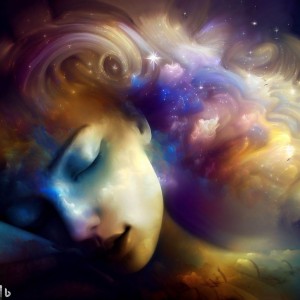Dreams and Emotions: The Subconscious Symphony of Nightly Visions and Feelings

Dreams and emotions form an intriguing labyrinth of the human mind, their interplay shaping our waking lives profoundly. In this article, we uncover the symbiotic relationship between the nocturnal fantasies we experience and the emotional spectrum they often provoke and reflect.
I. Introduction: Unraveling the Mystery of Dreams and Emotions
A. The Nocturnal Dance: Exploring the Waltz of Nightly Visions and Emotions
Delving into the intricacies of the human mind, the dance between dreams – or as some might call them, our nocturnal visions – and emotions is a captivating spectacle of psycho-neural dynamics. Often thought of as separate entities, these two components are deeply intertwined, each influencing the other in myriad ways. Just as a dancer responds to the rhythm of the music, so too do our emotions sway and sync with the patterns of our dreams. The intriguing interplay manifests while we slumber and continues to shape our waking lives, subconsciously swaying our thoughts, behaviors, and feelings.
B. Psychosomatic Enigma: The Crucial Role of Dreams and Emotions in Human Psychology
Dreams and emotions are pivotal in our psychological health, constituting an enigmatic part of our existence that has fascinated scientists, philosophers, and artists for centuries. Dreams, those mysterious dramas that unfold in our mind’s eye during sleep, have been linked to memory consolidation, problem-solving, and emotional processing. On the other hand, emotions are our immediate responses to the world around us, shaping our perception and playing a central role in our mental well-being. The relationship between these two phenomena is complex and intimate. Dreams often mirror our emotional state, becoming more vivid and emotionally intense during stress or trauma. Conversely, the emotional tone of our dreams can influence our mood upon waking, further underlining the cyclical relationship between our dreams and emotions. By understanding this bond, we can gain unique insights into our subconscious and unlock new ways to navigate and understand our psychological landscape.
II. The Nature of Dreams: An Exploration
A. Understanding Oneiric Experiences: The What and Why of Dreams
Dreams, the enchanting riddles of the subconscious mind, are a universal human experience. These nightly visions, known as oneiric experiences, often operate on their own rules, painting surreal narratives ranging from joyful escapades to nightmarish scenarios. But why do we dream? Various theories suggest that dreams facilitate psychological functions such as memory consolidation, learning, problem-solving, and emotional regulation. Others propose that dreams are random neural firings devoid of meaningful content. Regardless of the stance, one thing remains clear: dreams are a cornerstone of our inner mental life, a key player in the theatre of the mind.
B. Unconscious Theatre: The Various Themes of Dreams
Our unconscious mind is an ingenious playwright, weaving myriad themes into the fabric of our dreams. These themes can mirror daily experiences, known as the ‘day residue’ effect, or be far removed from our reality, delving into fantasy and symbolic representations. Some themes recur with noticeable frequency across individuals and cultures – being chased, flying, falling, or unable to move. These common themes may reflect shared human concerns or anxieties, yet interpreting these narratives is often deeply personal and unique to each dreamer.
C. The Reality of Dreams: Scientific Theories behind Sleep Visions
Science offers a more tangible perspective on dreams through various theories. The activation-synthesis theory, for example, suggests that dreams are the brain’s attempt to make sense of random neural activity during REM sleep. The threat simulation theory posits that dreams are a way for the brain to practice responding to threatening situations and honing survival skills. Conversely, the cognitive process dream theory views dreams as reflecting our cognitive processes or thoughts. These theories, while differing, underline the intricate relationship between brain activity and the dream world.
III. Emotions and their Impact: Delving Deeper
A. Emotional Spectrum: Understanding Human Emotions
Human emotions are complex, multifaceted phenomena, forming the spectrum of our internal experience. Emotions such as joy, anger, fear, and sadness are basic and universal, but we also experience numerous nuanced emotions like awe, guilt, jealousy, and nostalgia. These emotions play a fundamental role in our daily lives, shaping our perceptions, decision-making processes, and interpersonal interactions. Understanding this emotional spectrum, and its influence on our behavior, is crucial in comprehending human psychology.
B. Feelings Unveiled: How Emotions are Reflected in Dreams
Dreams often act as a mirror, reflecting our emotional states with startling clarity. The emotional content of dreams can vary widely, from euphoria to terror, mimicking the broad range of emotions we experience in waking life. More often than not, the emotional tone of our dreams aligns with our recent emotional experiences. For example, periods of stress or anxiety can give rise to unsettling or disturbing dreams. Understanding this reflective property of dreams can provide valuable insights into our emotional health.
C. Neurological Connections: How Emotions Influence Nightly Fantasies
Emotions are not merely abstract entities but are closely tied to our brain’s physiology. Specific regions, such as the amygdala, anterior cingulate cortex, and insular cortex, are instrumental in emotion processing. During REM sleep, when most dreaming occurs, these regions show high activity levels, signifying their role in generating emotionally-charged dreams. Furthermore, neurochemicals like serotonin and dopamine, often associated with mood regulation, influence dream content. Thus, our nightly fantasies are partly a result of the complex interplay between emotions and brain function.
IV. The Interlink Between Dreams and Emotions
A. Dreams as Emotional Regulators: The REM Connection
Dreams, particularly those occurring during Rapid Eye Movement (REM) sleep, have been proposed as a natural tool for emotional regulation. This function is often termed “overnight therapy.” Our brains actively process the day’s emotional experiences during REM sleep, integrating new experiences with existing memories and helping us navigate future emotional challenges. This neurocognitive activity during dreams may help us detach from the emotional intensity of the memory, facilitating psychological healing and resilience.
B. Emotional Expression: How Dreams Give Voice to Our Inner Feelings
Dreams can serve as a medium for our suppressed or unconscious feelings to surface, providing an uncensored platform for emotional expression. Often, emotions that we might struggle to articulate or confront in waking life find a voice in our dreams, creating narratives rich in emotional symbolism. From the fear symbolized by a pursuing monster to the joy represented by a peaceful meadow, dreams give form and image to our inner emotional world.
C. Mental Health and Dreaming: How Emotions Shape Our Dream Content
The interplay between dreams and emotions is particularly pronounced in mental health contexts. Research has shown that individuals experiencing depression or anxiety often report more negative dream content, indicative of their emotional state. In contrast, those on the pathway to recovery may start experiencing more positive and hopeful dreams. Thus, our emotional well-being significantly influences our dream narratives, making dreams potential markers for psychological health.
V. Therapeutic Perspectives: Using Dreams to Understand Emotions
A. Dream Therapy: An Emerging Field
Dream therapy is a burgeoning field in psychology that leverages the symbiotic relationship between dreams and emotions. Therapists can gain insight into a client’s emotional state, subconscious fears, and hidden desires by analyzing dream content. This therapeutic approach, grounded in psychodynamic theory, utilizes dream interpretations to uncover underlying emotional issues and facilitates personal growth and healing.
B. Case Studies: Effectiveness of Dream Therapy in Emotion Regulation
Many case studies highlight dream therapy’s effectiveness in emotion regulation. For instance, a case study of a patient suffering from recurring nightmares revealed that, through dream therapy, the patient could face their subconscious fears, leading to a decrease in nightmare frequency and intensity. Another case illustrated how dream therapy helped a client grieving a loss find emotional resolution. By addressing the symbolic representations of their grief in dreams, the client navigated their emotional turmoil and reached a state of acceptance. These cases underscore the potential of dream therapy as a conduit for emotional understanding and healing.
FAQs
Q: What is the connection between dreams and emotions?
A: Dreams and emotions share a complex, symbiotic relationship. Our emotional states can influence the content and tone of our dreams, while the emotions experienced in dreams can impact our mood upon waking.
Q: Can our dreams provide insights into our emotional health?
A: Dreams can be a reflective mirror, providing valuable insights into our emotional health. Frequent dreams with negative content might indicate emotional distress or a mental health issue.
Q: What role do dreams play in emotional regulation?
A: Dreams, particularly during REM sleep, can help regulate emotions by processing and integrating emotional experiences, thus promoting psychological healing and resilience.
Q: How can dream therapy assist in emotional regulation?
A: Dream therapy, by analyzing and interpreting dream content, can uncover underlying emotional issues, help individuals confront their subconscious fears, and facilitate personal growth and healing.
Q: Do emotions affect the intensity of dreams?
A: Yes, intense emotions, particularly negative ones like stress or anxiety, can lead to more vivid and often unsettling dreams.
Q: Can dreams reveal suppressed emotions?
A: Dreams can often act as a medium for suppressed or unconscious emotions to surface, providing a platform for emotional expression that may not be available or recognized in waking life.
Q: How can understanding the link between dreams and emotions benefit us?
A: Understanding the link between dreams and emotions can provide unique insights into our subconscious mind, emotional state, and overall psychological health. It can also guide therapeutic interventions, such as dream therapy.
Conclusion
A. Summary: Key Insights into the Interplay of Dreams and Emotions
Our journey into the labyrinth of dreams and emotions has unraveled a captivating dance between these two intricate aspects of human psychology. They intertwine in a mutual ballet, reflecting and influencing the other, shaping our nocturnal narratives and waking lives. From their role in emotional regulation to their potential in therapeutic interventions, understanding the interplay of dreams and emotions provides a window into our subconscious and emotional health.
B. Future Scope: Unanswered Questions and Possible Future Research Directions
While we have come a long way in understanding the bond between dreams and emotions, numerous mysteries remain. How precisely do various emotions influence dream content? What are the mechanisms through which dreams aid emotional regulation? Future research could explore these questions, using technological advances in neuroscience and cognitive psychology to illuminate this fascinating aspect of human experience further.
Suggested Readings
Dreams and emotions have captivated human curiosity for ages, and many scholars have penned their insights into this captivating realm. Here are some compelling reads that delve into this subject with depth and clarity:
- “The Dreamer’s Dance: An Odyssey into Dreams and Emotions” – This book provides a comprehensive journey into the intertwining world of dreams and emotions, unraveling their impact on our waking lives.
- “Nightly Visions, Daily Emotions: The Psychology of Dreaming” – This exploration of dream psychology offers fascinating insights into how our emotional state shapes and is shaped by our dreams.
- “The Emotional Echo: How Dreams Reflect Our Feelings” – This book discusses the reflection of our emotional states in our dreams, providing a deeper understanding of our emotional health.
- “Bridging Sleep and Wakefulness: Dreams and Emotions Unveiled” – A thorough and engaging analysis of the intricate link between dreams and emotions, offering valuable psychological insights.
- “Dream Therapy: Healing through Nightly Visions” – An in-depth look at the emerging field of dream therapy, demonstrating how understanding our dreams can guide us in navigating our emotional landscape.
Embarking on these readings will deepen your understanding of the fascinating world of dreams and emotions, providing new lenses to view your nocturnal narratives and emotional spectrum.






